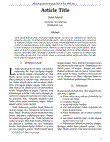Resultados de búsqueda - "Europe"
Materias dentro de su búsqueda.
Materias dentro de su búsqueda.
- Mexico 2
- México 2
- estudiantes 2
- , proteccionismo 1
- América 1
- Announcement, denounciation, prophesy, Juan Donoso Cortés 1
- Anuncia, denuncia, profecía, Juan Donoso Cortés 1
- Bioeconomia 1
- Bioeconomy 1
- Bolsonaro 1
- Brasil 1
- Brazil 1
- Central Europe 1
- China 1
- Condicionantes 1
- Conditions 1
- Espacios verdes; renovación urbana; desarrollo sostenible 1
- España 1
- Europa Central 1
- Foreign Policy of Mexico 1
- Foreign investment 1
- Grupo Visegrado 1
- Guerras napoleónicas, batalla de Waterloo, Napoleón Bonaparte, Grand Armée, Historia de la guerra 1
- Hortaliza 1
- Inversión extranjera 1
- Lech Walesa 1
- Mexican identity 1
- Migración 1
- Migration 1
- Migratory sistems 1
-
41
Allergen sensitization linked to climate and age, not to intermittent-persistent rhinitis in a cross-sectional cohort study in the (sub)tropics
Publicado 2014“…Conclusions: In a country with (sub)tropical climate zones SPT sensitization patterns varied according to climatological zones; they were different from those found in Europe, HDM sensitization far outweighing pollen allergies and Bermuda grass and Ash pollen being the main grass and tree allergens, respectively. …”
Enlace del recurso
Artículo -
42
Anti-Trypanosoma cruzi antibodies in Latin American migrants in transit through the México- USA border
Publicado 2018“…Palabras clave: Trypanosoma cruzi; enfermedad de Chagas; migrantes; estudios seroepidemiológicos; ensayo de inmunoadsorción enzimática; hemaglutinación. doi Anti-Trypanosoma cruzi antibodies in Latin American migrants in transit through the MéxicoUSA border Introduction: In recent years, American trypanosomiasis has become an emergent public health problem in countries receiving migrant populations such as México, USA, Canada or those in Europe. Objective: To analyze the prevalence of anti-Trypanosoma cruzi antibodies in Latin American migrants on their way to USA and Canada by means of serological techniques. …”
Enlace del recurso
Artículo -
43
-
44
Global Trends in Aquaculture and Feed Ingredient Use in Compound Aquafeeds
Publicado 2013“…By region, Asia accounted for over 91.2 percent of total global aquaculture production in 2011 (APR 8.46 percent since 1984), followed by the Americas at 3.53 percent (APR 7.59 percent), Europe at 3.20 percent (APR 3.99 percent), Africa at 1.84 percent (APR 14.82 percent), and Oceania at 0.25 percent (APR 9.02 percent).In terms of the major farmed species groups in 2011, finfish accounted for 41.6 million tonnes or 49.8 percent of total global aquaculture production in 2011 (valued at US $ 83.6 billion, with over 102 reported fish species, and production growing at an average APR of 8.85 percent since 1984), followed by aquatic plants at 21.0 million tonnes or 25.1% of total global production (valued at US $ 5.5 billion, with 12 reported aquatic plant species, and production growing at an average APR of 7.16 percent since 1984), molluscs at 14.4 million tonnes or 17.2 percent of total global production (valued at US $ 15.3 billion, with 27 reported mollusk species, and production growing at an average APR of 7.17 percent since 1984), and crustaceans at 5.9 million tonnes or 7.0 percent of total global production (valued at US $ 28.4 billion, with 15 reported crustacean species, and production growing at an average APR 13.1 percent since 1984; FAO, 2013).The total production of the major finfish and crustacean species groups fed industrially compounded or farm-made aquafeeds was reported to be 40.57 million tonnes in 2011 (FAO, 2013), with total global industrial compound aquafeed production estimated at approximately 35.75 million tonnes; the major compound feed fed species groups including: Chinese carp at 11.76 million tonnes (excluding silver carp and big head carp) with an estimated total compound aquafeed requirement of 10.19 million tonnes; Tilapia at 3.96 million tonnes with an estimated total compound aquafeed requirement of 5.79 million tonnes or 16.2 percent of total global compound aquafeed production;Shrimp at 3.93 million tonnes with an estimated total compound feed requirement of 5.54 million tonnes or 15.5 percent of total global compound aquafeed production; Catfish at 3.38 million tonnes with an estimated total compound feed requirement of 3.70 million tonnes or 10.3 percent of total global compound aquafeed production; Marine fish at 2.01 million tonnes with an estimated total compound feed requirement of 2.82 million tonnes or 7.9 percent of total global compound aquafeed production; Other freshwater and diadromous fish at 1.94 million tonnes with an estimated total compound feed requirement of 1.24 million tonnes or 3.5 percent of total global compound aquafeed production; Salmon at 1.93 million tonnes with an estimated total compound feed requirement of 2.51 million tonnes or 7.0 percent of total global compound aquafeed production; Freshwater crustaceans at 1.67 million tonnes with an estimated total compound feed requirement of 1.71 million tonnes or 4.8 percent of total global compound aquafeed production; Milkfish at 891,407 tonnes with an estimated total compound feed requirement of 820,000 tonnes or 2.3 percent of total global compound aquafeed production; Trout at 791,959 tonnes with an estimated total compound feed requirement of 1.03 million tonnes or 2.9 percent of total global compound aquafeed production; Eel at 255,284 tonnes with an estimated total compound feed requirement of 392,000 tonnes or 1.1 percent of total global compound aquafeed production in 2011.In terms of feed ingredient usage, the compound aquafeed sector still remains the largest consumer of fishmeal and fish oil, aquaculture consuming 78 percent of total global fish oil production in 2011 (major aquaculture species group consumer being salmonids at 66 percent followed by marine fish at 17 percent) and 68% of total global fishmeal production in 2011 (major aquaculture species group consumer being crustaceans at 30 percent, followed by salmonids at 22 percent, and marine fish at 21 percent; Dr Andrew Jackson, personal communication, The Marine Ingredients Organization, http://iffo.net). …”
Enlace del recurso
Artículo -
45
Caracterización genética de cepas de parvovirus canino presentes en el área metropolitana de Monterrey, Nuevo León
Publicado 2019“…Likewise, by means of the genetic analyses, it was evidenced that the subtypes of the CPV2c are distributed with groups detected in the USA, Europe, and Mexico. Interestingly, a single phylogenetic group separated from the rest of the groups previously reported in subtype CPV2c was detected. …”
Enlace del recurso
Tesis -
46
Caracterización genética de cepas de parvovirus canino presentes en el área metropolitana de Monterrey, Nuevo León
Publicado 2019“…Likewise, by means of the genetic analyses, it was evidenced that the subtypes of the CPV2c are distributed with groups detected in the USA, Europe, and Mexico. Interestingly, a single phylogenetic group separated from the rest of the groups previously reported in subtype CPV2c was detected. …”
Enlace del recurso
Tesis


